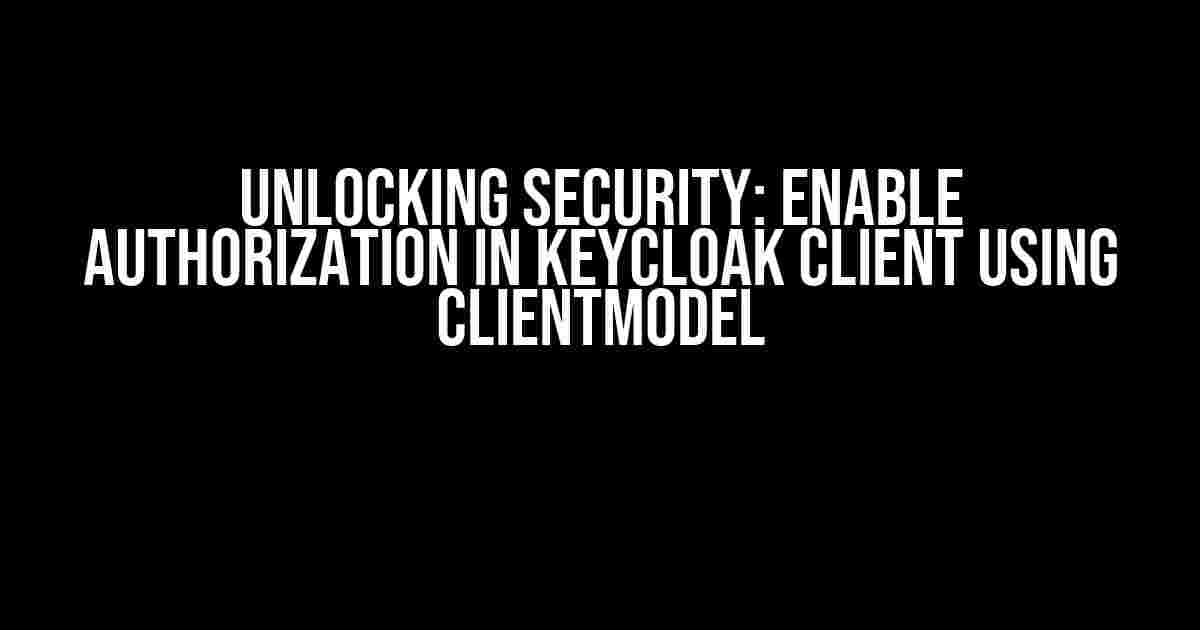Are you tired of dealing with insecure applications? Do you want to add an extra layer of protection to your Keycloak client? Look no further! In this article, we’ll dive into the world of authorization and explore how to enable it in your Keycloak client using ClientModel. Buckle up, because we’re about to get secure!
What is Keycloak?
Before we dive into the nitty-gritty, let’s take a quick look at what Keycloak is. Keycloak is an open-source identity and access management solution that provides a single platform for authentication, authorization, and identity management. It’s a powerful tool that helps you secure your applications and services with ease.
What is ClientModel?
ClientModel is a crucial component in Keycloak that represents a client, which is an application or service that requests access to a protected resource. It’s a configuration entity that defines how the client interacts with Keycloak. Think of it as a blueprint for your client’s identity and behavior.
Why Do I Need Authorization?
So, why do you need authorization in your Keycloak client? Simply put, authorization ensures that only authorized users have access to specific resources and functionality within your application. Without authorization, you’re leaving your application vulnerable to unauthorized access, which can lead to a plethora of security issues.
Enabling Authorization in Keycloak Client using ClientModel
Now that we’ve covered the basics, let’s get to the good stuff! Enabling authorization in your Keycloak client using ClientModel is a straightforward process. Follow these steps to lock down your application:
-
Step 1: Create a New Client
Login to your Keycloak console and navigate to the
Clientstab. Click theNew Clientbutton to create a new client.curl -X POST \ https://your-keycloak-server.com/auth/admin/realms/your-realm/clients \ -H 'Authorization: Bearer YOUR_ACCESS_TOKEN' \ -H 'Content-Type: application/json' \ -d '{"clientId": "your-client-id", "name": "Your Client", "enabled": true}' -
Step 2: Configure ClientModel
Update your ClientModel configuration to include authorization settings. You can do this using the Keycloak REST API or the console.
curl -X PATCH \ https://your-keycloak-server.com/auth/admin/realms/your-realm/clients/your-client-id \ -H 'Authorization: Bearer YOUR_ACCESS_TOKEN' \ -H 'Content-Type: application/json' \ -d '{"authorizationSettings": {"allowRemoteResourceManagement": true, "allowWebOrigins": true}}' -
Step 3: Define Permissions
Define permissions for your client using the Keycloak REST API or the console. This will determine what resources and actions are allowed for your client.
Permission Description view_profiles View user profiles manage_clients Manage clients read_resource Read protected resources -
Step 4: Assign Roles
Assign roles to users or groups that should have access to specific permissions. This will ensure that only authorized users have access to protected resources.
- Assign the
adminrole to administrators - Assign the
userrole to end-users
- Assign the
-
Step 5: Implement Authorization in Your Application
Finally, implement authorization in your application using the Keycloak Java adapter or another language-specific adapter. This will ensure that your application enforces the permissions and roles defined in Keycloak.
@GET @Path("/protected-resource") @RolesAllowed("admin") public String protectedResource() { return "Hello, admin!"; }
Troubleshooting Common Issues
Encountered an issue while enabling authorization in your Keycloak client using ClientModel? Don’t worry, we’ve got you covered! Here are some common issues and their solutions:
-
Error: ClientModel Not Found
Solution: Ensure that the ClientModel is correctly configured and exists in your Keycloak realm.
-
Error: Permission Denied
Solution: Check that the user has the required role and permission to access the protected resource.
-
Error: Authorization Settings Not Applied
Solution: Verify that the authorization settings are correctly applied to the ClientModel and that the client is configured to use the correct realm.
Conclusion
And that’s it! You’ve successfully enabled authorization in your Keycloak client using ClientModel. By following these steps, you’ve added an extra layer of security to your application and ensured that only authorized users have access to protected resources.
What’s Next?
Now that you’ve mastered authorization in Keycloak, why not explore other advanced security features, such as:
- Implementing multi-factor authentication
- Configuring fine-grained access control
- Integrating with external identity providers
The world of security is vast and exciting, and Keycloak is your gateway to unlocking its full potential. Stay secure, and happy coding!
Sidebar:
Want to learn more about Keycloak and its features? Check out the official Keycloak documentation and our blog for more tutorials, guides, and security tips.
Here is the FAQ about enabling authorization in Keycloak client using ClientModel:
Frequently Asked Question
Got questions about enabling authorization in Keycloak client using ClientModel? We’ve got answers!
What is the purpose of enabling authorization in Keycloak client?
Enabling authorization in a Keycloak client allows you to control access to your application’s resources by granting or denying permissions to users based on their roles, groups, or other attributes. This ensures that only authorized users can access certain features or data, thereby securing your application.
How do I enable authorization in a Keycloak client using ClientModel?
To enable authorization in a Keycloak client using ClientModel, you need to set the `access` attribute of the ClientModel to `CONFIDENTIAL` or `PUBLIC` and configure the `authorizationSettings` with the required settings, such as the authorization scope, policies, and permissions.
What are the different authorization settings I can configure in ClientModel?
In ClientModel, you can configure various authorization settings, such as the authorization scope, policies, permissions, and roles. You can also define custom settings, such as custom permissions, attributes, and filters, to fine-tune access control for your application.
How do I test authorization in a Keycloak client using ClientModel?
To test authorization in a Keycloak client using ClientModel, you can use Keycloak’s built-in testing tools, such as the Keycloak Admin Console or the Keycloak API. You can also write unit tests or integration tests for your application to verify that authorization is working as expected.
What are the benefits of enabling authorization in a Keycloak client using ClientModel?
Enabling authorization in a Keycloak client using ClientModel provides several benefits, including improved security, fine-grained access control, and easier management of permissions and roles. It also allows you to scale your application securely and ensures compliance with regulatory requirements.
